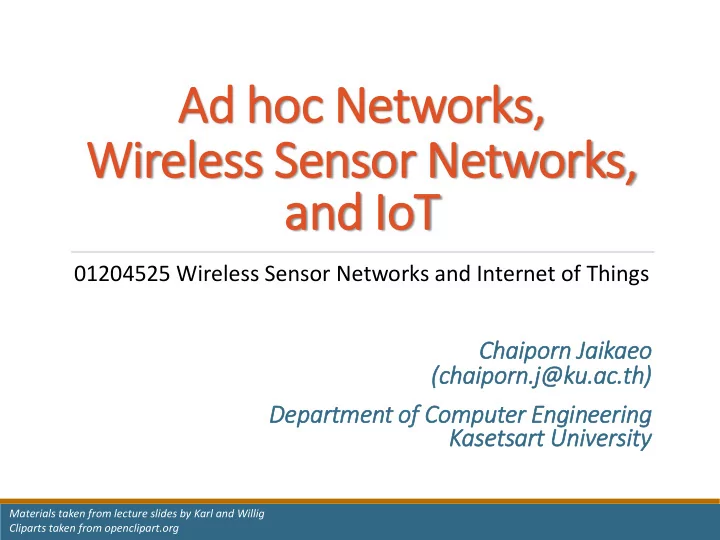

Ad hoc Networks, Wireless Sensor Networks, and IoT 01204525 Wireless Sensor Networks and Internet of Things Chaiporn Ja Jaikaeo (c (chaiporn.j@ku.ac.th) Department of f Computer Engineering Kasetsart University Materials taken from lecture slides by Karl and Willig Cliparts taken from openclipart.org
Typical Wireless Networks • Base stations connected to wired backbone • Mobile nodes communicate wirelessly to base stations 2
Ad hoc Networks • Networks without pre-configured infrastructure ◦ require no hubs, access points, base stations ◦ are instantly deployable ◦ can be wired or wireless wired wireless multi-hop wireless • Initially targeted for military and emergency applications 3
IEEE 802.11 Ad hoc Mode • IEEE 802.11 already provides support for ad hoc mode • Computers can be connected without an access point • Only work with single hop 4
Applications of Ad hoc Networks Factory Floor Disaster recovery Car-to-car communication Automation 5 5
Characteristics of Ad hoc Networks • Heterogeneity ― sensors, PDAs, laptops • Limited resources ― CPU, bandwidth, power • Dynamic topology due to mobility and/or failure ◦ Mobile Ad hoc Networks (MANETs) B C A 8
Sensor Networks • Participants in the previous examples were devices close to a human user, interacting with humans • Alternative concept: • Instead of focusing interaction on humans, focus on interacting with environments ◦ Network is embedded in environment ◦ Nodes in the network are equipped with sensing and actuation to measure/influence environment ◦ Nodes process information and communicate 9
Traditional Sensors Network sensor field Remote monitoring Data loggers Local monitoring 10 10
Wireless Sensors • Sensors communicate with data logger via radio links Network sensor field Remote monitoring radio link 11
Wireless Sensor Networks • Wireless sensors + wireless network • Sensor nodes (motes) deployed and forming an ad hoc network ◦ Requires no hubs, access points ◦ Instantly deployable Sensor node/mote Sensor network Gateway Internet • Targeted applications ◦ Emergency responses ◦ Remote data acquisition Remote monitoring 12
Internet of Things (IoT) http://www.opinno.com/en/content/internet-things-0 13 13
Connected Living NTT DoCoMo, Japan http://www.dezeen.com/2013/09/11/nismo-smartwatch/ 14 14
Demonstration
Sensor Modules • NodeMCU-32S ◦ Processor: ESP32, 48MHz dual-core WiFi/Bluetooth SoC ◦ Sensors: light sensor and switch ◦ Actuator: dimmable LED • Software running on MicroPython 16
Scenario Internet • subscribe for sensor status • publish sensor status • publish LED brightness • subscribe for LED brightness Light Sensor + Switch + LED MQTT Broker 17
WSN/IoT Platforms • Various communication protocols: BLE, IEEE802.15.4, IEEE802.11, LoRa, etc. and many more… 18
Current Trends • Most WSN/IoT devices are now based on SoC (System on Chip) NXP's JN5168 Module ESP8266 Module ESP32 Module • • • 32-bit RISC CPU @80 MHz 32-bit dual-core @240 MHz 32-bit RISC CPU @32MHz • • • 1MB flash, 80KB RAM 4MB flash, 520KB RAM 256KB flash, 32KB RAM • • • 2.4GHz Wi-Fi Wi-Fi + Bluetooth 2.4GHz IEEE 802.15.4 • • • ~370 THB ~110 THB ~290 THB 19
WSN/IoT Application Examples • Agriculture ◦ Humidity/temperature monitoring • Civil engineering ◦ Structural response ◦ Disaster management • Environmental sciences ◦ Habitat monitoring ◦ Conservation biology 20
Landslide Monitor • Real deployment scenario… 21
Roles of Participants in WSN • Sources of data: Measure data, report them “somewhere” ◦ Typically equip with different kinds of actual sensors • Sinks of data: Interested in receiving data from WSN ◦ May be part of the WSN or external entity, PDA, gateway, … • Actuators (actors): Control some device based on data, usually also a sink WSN = WASN 22
Classifying Application Types • Interaction patterns between sources and sinks classify application types ◦ Event detection ◦ Periodic measurement ◦ Function approximation ◦ Edge detection ◦ Tracking 23
Deployment Options • Dropped from aircraft ◦ Random deployment • Well planned, fixed ◦ Regular deployment • Mobile sensor nodes ◦ Can move to compensate for deployment shortcomings ◦ Can be passively moved around by some external force (wind, water) ◦ Can actively seek out “interesting” areas 24
Maintenance Options • Feasible and/or practical to maintain sensor nodes? ◦ Replace batteries ◦ Unattended operation ◦ Impossible but not relevant • Energy supply ◦ Limited from point of deployment ◦ Some form of recharging / energy scavenging 25
Required Mechanisms • Multi-hop wireless communication • Energy-efficient operation ◦ Both for communication and computation, sensing, actuating • Auto-configuration ◦ Manual configuration just not an option • Collaboration & in-network processing ◦ Nodes in the network collaborate towards a joint goal ◦ Pre-processing data in network (as opposed to at the edge) can greatly improve efficiency 26
Required Mechanisms • Data centric networking ◦ Focusing network design on data, not on node identifies (id-centric networking) ◦ To improve efficiency • Locality ◦ Do things locally (on node or among nearby neighbors) as much as possible • Exploit tradeoffs ◦ E.g., between invested energy and accuracy 27
MANET vs. WSN - Similarities • MANET – M obile A d hoc Net work • Self-organization • Energy efficiency • (Often) Wireless multi-hop 28
MANET vs. WSN - Differences • Equipment: MANETs more powerful • Application-specific: WSNs depend much stronger on application specifics • Environment interaction: core of WSN/IoT, absent in MANET • Scale: WSN might be much larger (although contestable) • Energy: WSN tighter requirements, maintenance issues 29
MANET vs. WSN - Differences • Dependability/QoS: in WSN, individual node may be dispensable (network matters), QoS different because of different applications • Addressing: Data centric vs. id-centric networking 30
Enabling Technologies for WSN/IoT • Cost reduction ◦ For wireless communication, simple microcontroller, system on chip, sensing, batteries • Miniaturization ◦ Some applications demand small size ◦ “Smart dust” as the most extreme vision • Energy scavenging ◦ Recharge batteries from ambient energy (light, vibration, …) 31
Conclusion • Ad hoc networks, WSNs, and IoT are challenging and promising system concepts • They require new types of architectures & protocols compared to “traditional” wired/wireless networks • In particular, application-specificness is a new issue 32
Recommend
More recommend